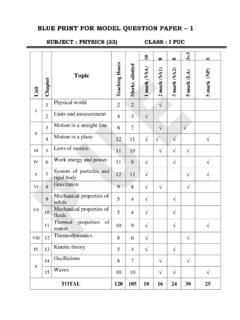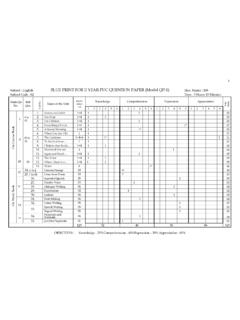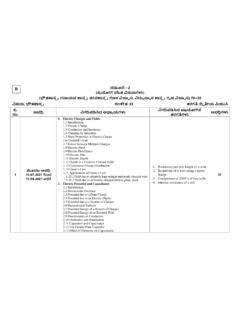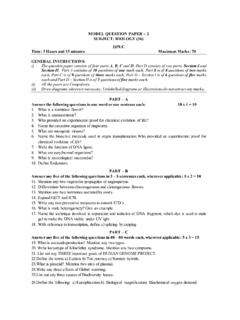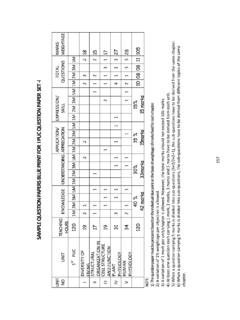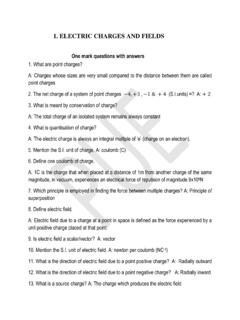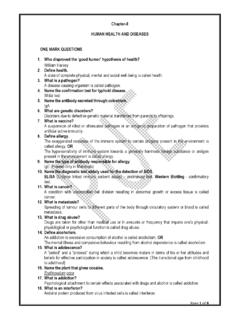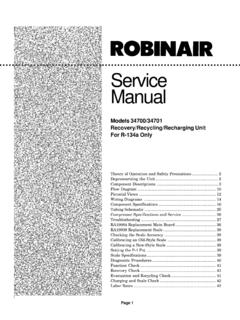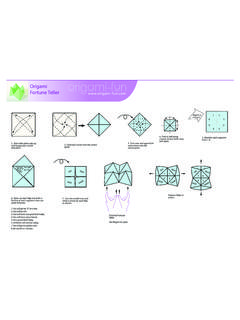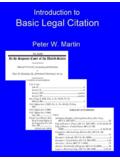Transcription of Blue print for Model question paper I PUC-PHYSICS
1 blue print FOR Model question paper 1. SUBJECT : PHYSICS (33) CLASS : I PUC. blue print for Model question paper I PUC-PHYSICS . 3+3. 10. 8. 8. 5. Teaching Hours Marks allotted 1 mark (VSA). 2 mark (SA1). 3 mark (SA2). 5 mark (NP). 5 mark (LA). Topic Chapter Unit 1 Physical world 2 2 . I. Units and measurement 2 4 3 . Motion in a straight line 3 8 7 . II. Motion in a plane 4 12 11 . III 5 Laws of motion 11 10 . IV 6 Work energy and power 11 9 . System of particles and V 7. rigid body 12 11 . VI 8 Gravitation 9 8 . Mechanical properties of 9. solids 5 4 . VII Mechanical properties of 10. fluids 5 4 . Thermal properties of 11. matter 10 9 . VIII 12 Thermodynamics 8 6 . IX 13 Kinetic theory 5 4 . 14 Oscillations 8 7 . X. 15 Waves 10 10 . TOTAL 120 105 10 16 24 30 25. Model question paper 1. I PHYSICS (33). Time: 3 hours 15 min. Max. Marks: 70. General instructions: a) All parts are compulsory.
2 B) Answers without relevant diagram/ figure/circuit wherever necessary will not carry any marks. c) Direct answers to the Numerical problems without detailed solutions will not carry any marks. PART - A. I. Answer the following 10 x 1 = 1. 1. Write the S I t of momentum. 2. Is scalar multiplied by a vector, a vector or a scalar? 3. Write an expression for position vector of centre mass of system of two particles lie on x - axis 4. Mention the expression for work done by a force in vector form. 5. What is the height of the geostationary orbit form the surface of the earth?. 6. Among rubber and steel which one has more elasticity? 7. What is ideal gas? 8. Define angle of contact. 9. State the first law of thermodynamics. 10. Mention any one applications of beats. PART B. II. Answer any FIVE of the following questions. 5 2=10. 11. Mention any two basic forces in nature. 12. Mention two uses of dimensional analysis 13.
3 Distinguish between distance (path length) and displacement. 14. What is centripetal acceleration? Give the expression for it. 15. Mention any two methods of reducing friction 16. Determine the volume contraction of the solid copper cube, 10cm on its edge, when subjected to hydraulic pressure of x106Pa.( Given bulk modulus of copper =140x10 Nm-2). 17. What is specific heat capacity of a substance? Write the relation between specific heat capacities of gases. 18. On an average the human heart is found to beat 75 times in minute. Calculate its frequency. PART C. III. Answer any FIVE of the following questions. 5 3=15. 19. State and explain Law of triangle of vectors. When will be the resultant of two given vectors is maximum? 20. State Newton's second law of motion and hence derive F = ma . 21. Prove work- energy theorem for a constant force 22. Derive an expressions orbital speed of the earth's satellite.
4 23. state and explain Bernoulli's theorem. 24. Write any three properties of heat radiation. 25. State the law of equipartition of energy. Write an expression for the energy associated with diatomic molecule. 26. Discus the modes of vibrations in closed path. PART D. IV. Answer any TWO of the following questions. 2 5=10. 1 2. 27. Derive x v o t at by graphical method. 2. 28. State and prove the law of conservation of linear momentum in case of collision of two bodies. 29. Derive the relation between torque and angular momentum of a particle. V. Answer any TWO of the following questions. 2 5=10. 30. State and explain Kepler's laws of planetary motion. 31. Write a note on kelvin scale of temperature. 32. Derive an expression for period of simple pendulum. any THREE of the following questions. 3 5=15. 33. The ceiling of a long hall is 25 m high. What is the maximum horizontal distance that a ball thrown with a speed of 40 m s 1 can go without hitting the ceiling of the hall?
5 34. A pump on the ground floor of a building can pump up water to fill a tank of volume 30 m 3 in 15 min. If the tank is 40 m above the ground, and the efficiency of the pump is 30%, how much electric power is consumed by the pump? 35. A 5 kg wheel is given an acceleration of 10 rad/sec2 by an applied torque of 2 N-m. Calculate its (a) moment of inertia and (b) radius of gyration. 36. A steam engine delivers of work per minute and serves of heat per minute from its boiler. what is the efficiency of the engine? How much heat is wasted per minute. 37. A train standing at the outer signal of railway station blows a whistle of frequency 400Hz in still air. i) what is the frequency of the whistle for a platform observer when the train (a). approaches the platform with a speed of 10m/s. b) recedes from the platform with a speed of 10m/s? ii) what is the speed of the sound in each case. the speed of sound in still can be taken as 340m/s.
6 SCHEME OF EVALUATION FOR I PU PHYSICS Model question paper 1. PART - A. I. Answer the following 10 x 1 = 10. 1. Write the S I t of momentum. kg ms-1. 1. 2. Is scalar multiplied by a vector, a vector or a scalar? It is a vector 1. 3. Write an expression for position vetor of centre mass of system of two particles on x axis. 1. 4. Mention the expression for work done by a forcce in vector form. W= 1. 5. State Hook's law. With in elastic limit stress is directly proportional to strain 1. 6. Amomg rubber and steel which one has more elasticity? Steel 1. 7. What is an ideal gas? A gas which obeys both boyle's law and charle's law is called ideal gas 1. 8. Define angle of contact. It is an angle between the tangent drawn to the surface of liquid at the point of contact with the surface of contact with in the liquid. 1. 9. State the first law of thermodynamics. The law stats that heat energy given to the system is equal to sum of the increase in internal energy and work done by the systerm.
7 1. 10. Mention any one application of beats. Beats are used to tune the musical instruments. They are used to detect the poisonous gases in mines. or any use 1. PART B. II. Answer any FIVE of the following questions. 5 2=10. 11. Mention any two basic forces in nature. Gravitational force one each Electral force Strong nuclear force Weak nuclear force ( any two). 12. Mention two uses of dimensional analysis Any two of the following one each Check the correctness of the equation To convert unit of physical quantity in one system into other system of units To derive the relation between physical quintiles 13. Distinguish between distance (path length) and displacement. one each Distnce or path length displacement It is the length of the path It is the shortest distance along which the body moved between initial final positions. It a scalar It is a vector It cannot be negative It can be negative,positive or zero 14.
8 What is centripetal acceleration? Give the expression for it. The acceleration of a body towards the centre of a circular path along which the body moves 1. a = v2/r= r2 1. 15. Mention any two methods of reducing friction Any two one each Using lubricants, using ball bearings, by smoothening the surface etc. 16. Determine the volume contraction of the solid copper cube, 10cm on its edge, when subjected to hydraulic pressure of x106Pa.( Given bulk modulus of copper =140Nm-2). =. 17. What is specific heat capacity of a substance? writethe relation between specific heat capacities of gases. It is the quantity of heat required to raise temperature of one kg of sbstance through one degree celcius. 1. CP CV= R 1. 18. On an average the human heart is found to beat 75 times in minute. calculate its frequency. f = number of oscillations /time 1. f= 1. PART C. III. Answer any FIVE of the following questions.
9 5 3=15. 19 . State and explain Law of triangle of vectors. when will be the resultant of two given vectors is maximum? Statement 1. Explanation/fig 1. =0 1. 20. State Newton's second law of motion and hence derive F = ma . Statement 1. Explanation 1. Arriving at f = ma 1. 21. Prove work- energy theorem for a constant force. v2 = u2 + 2 a x 1. 1 m m(v 2 - u 2 ) = 2ax 2 2. 1 1. mv 2 - mu 2 = m a x 1. 2 2. Final KE Initial KE = F x Change in kinetic energy = work done 1. 22. Derive an expressions orbital speed of the earth's satellite. Figure 1. Centripetal force = gravitational force. m vo 2 G M m = 1. r r2. GM. vo =. r GM. vo = 1. R h 23. State and expalin Bernoulies theorem. Statement. 1. Explanation. Consider an incompressible liquid of density be flowing through a pipe at a height h from the reference level as shown in the figure. Let v be the velocity. According to Bernoulli's theorem, v2 + g h + p/ = constant.
10 2. 24. Wite any three properties of heat radiation. Any properties 1each 25. State the law of equipartition of energy. write an expression for the energy associated with diatomic molecule. Statement 1. U= (5/2) kT 1. Explanation of symbols. 1. 25. Discus the modes of vibrations in closed path. 1. l l l First (Fundamental) mode of vibration v f1 = -------->(1). 4 l For second mode of vibration: v = f2 2. v f2 =. 2. f2 = 3 f1 -------->(2) 1. From Equations(1),and(2) it is found that, f1:f2:f3: = . = 1:3:5: 1. PART D. IV. Answer any TWO of the following questions. 2 5=10. 1 2. 27. Derive x v o t at by graphical method. 2. Velocity B. v u u O t D Time 1. In the above v-t graph, AO= DC = u is the initial velocity of the body , BD = v is the final velocity of the body , BC= (v-u ) is the change in velocity in time interval t . Let a' be the uniform acceleration and x' be the displacement of the body.

